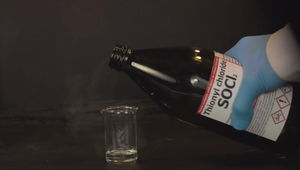Difference between revisions of "Thionyl chloride"
(Added chemical compound lists of sulfur and oxygen compounds.) |
|||
| Line 172: | Line 172: | ||
*[http://www.sciencemadness.org/talk/viewthread.php?tid=1439 HELP! need thionyl chloride(SOCl2) synthesis] | *[http://www.sciencemadness.org/talk/viewthread.php?tid=1439 HELP! need thionyl chloride(SOCl2) synthesis] | ||
*[http://www.sciencemadness.org/talk/viewthread.php?tid=9407 thionyl chloride and potassium dichromate] | *[http://www.sciencemadness.org/talk/viewthread.php?tid=9407 thionyl chloride and potassium dichromate] | ||
| + | |||
| + | {{Template:Sulfur compounds}} | ||
| + | {{Template:Oxygen compounds}} | ||
[[Category:Chemical compounds]] | [[Category:Chemical compounds]] | ||
Revision as of 21:12, 25 September 2020
 Thionyl chloride sample, fuming in open air.
| |
| Names | |
|---|---|
| IUPAC name
Sulfurous dichloride
| |
| Other names
Dichlorosulfoxide
Sulfinyl chloride Sulfinyl dichloride Sulfur monoxide dichloride Sulfur oxide dichloride Sulfurous oxychloride Sulfuryl(IV) chloride Thionyl dichloride | |
| Identifiers | |
| Jmol-3D images | Image |
| |
| Properties | |
| SOCl2 | |
| Molar mass | 118.97 g/mol |
| Appearance | Colorless fuming liquid (fresh) Yellowish fuming liquid (old) |
| Odor | Suffocating, sulfur dioxide-like |
| Density | 1.638 g/cm3 (at 20 °C) |
| Melting point | −104.5 °C (−156.1 °F; 168.7 K) |
| Boiling point | 74.6 °C (166.3 °F; 347.8 K) |
| Reacts | |
| Solubility | Reacts with alcohols, aldehydes, carboxylic acids, ketones, DMF, DMSO Miscible with benzene, carbon tetrachloride, chloroform, ethers, toluene |
| Vapor pressure | 15.7 kPa (25 °C) 4.7 kPa (0 °C) 384 Pa (-40 °C) |
| Thermochemistry | |
| Std molar
entropy (S |
309.8 kJ/mol (gas) |
| Std enthalpy of
formation (ΔfH |
-245.6 kJ/mol (liquid) |
| Hazards | |
| Safety data sheet | ScinceLab |
| Flash point | Non-flammable |
| Related compounds | |
| Related compounds
|
Sulfuryl chloride |
| Except where otherwise noted, data are given for materials in their standard state (at 25 °C [77 °F], 100 kPa). | |
| Infobox references | |
Thionyl chloride is an inorganic compound with the chemical formula SOCl2. It is an extremely useful compound in chemistry, but it is extremely dangerous and toxic.
Thionyl chloride is sometimes confused with sulfuryl chloride, SO2Cl2, but the properties of these compounds differ significantly: Thionyl chloride is a source of chloride ions, while sulfuryl chloride is a source of chlorine.
Contents
Properties
Chemical
Thionyl chloride reacts on contact with water to form sulfur dioxide and hydrogen chloride/hydrochloric acid mist, process which is extremely exothermic:
- SOCl2 + H2O → 2 HCl + SO2
Thionyl chloride will convert carboxylic acids to acyl chlorides:
- SOCl2 + RCO2H → RC(O)Cl + SO2 + HCl
This reaction can be used to synthesize acetic anhydride.
Physical
Thionyl chloride is a colorless oily liquid that fumes in air. Old samples have a yellowish color, due to decomposition. Light accelerates its decomposition. Thionyl chloride reacts with water, carboxylic acids, alcohols and all protic solvents. It is however miscible and soluble in most aprotic solvents, such as benzene, carbon tetrachloride, chloroform, diethyl ether, toluene, xylene. Thionyl chloride melts at −104.5 °C and boils at 74.6 °C. It has a density of 1.638 g/cm3 at 20 °C.
Availability
Thionyl chloride is sold by various chemical suppliers, but due to its hazards it's generally not available to the amateur chemist. Its sale is regulated in many places.
Certain batteries contain small amounts of thionyl chloride, but it's impractical to extract it.
Thionyl chloride is listed on schedule 3 of the Chemical Weapons Convention and ordering large amounts may draw attention of the authorities.
Preparation
Unlike its similar compound sulfuryl chloride, thionyl chloride is much more difficult to synthesize.
Industrially it's prepared by reacting sulfur trioxide with sulfur dichloride:
- SO3 + SCl2 → SOCl2 + SO2
Oleum can be used instead of sulfur trioxide, and this is usually preferred, as pure sulfur trioxide is a nightmare to produce, purify, store and use, while oleum is much easier to handle, even though it's not a pleasant experience either. The higher the sulfur trioxide concentration, the better the reaction yield is.
The resulting thionyl chloride is extracted via fractional distillation, best in low light conditions, under dry atmosphere.
SM user Magpie has made a small amount of thionyl chloride.
A more dangerous method involves the reaction between sulfur dioxide and phosgene:
- SO2 + COCl2 → SOCl2 + CO2
However, due to phosgene's extreme toxicity, it's best to avoid this reaction all together.
Projects
- Make acyl chlorides
- Make anhydrous metal chlorides
- Make anhydrous alcoholic solutions of HCl
Handling
Safety
Thionyl chloride is extremely toxic and should not be handled unless you're a professional. It reacts violently with water to give sulfur dioxide and hydrochloric acid, which are toxic and corrosive.
Storage
Thionyl chloride is best stored in sealed bottles, in a special cabinet, away from any light and moisture.
Disposal
Thionyl chloride can be safely neutralized by adding it to an alkaline slurry or with dry calcium or sodium carbonate or bicarbonate. Neutralization must be done outside, or in a fumehood, as the neutralization releases a corrosive mist of HCl.
References
Relevant Sciencemadness threads
- Preparation of Thionyl Chloride
- thionyl chloride synthesis
- HELP! need thionyl chloride(SOCl2) synthesis
- thionyl chloride and potassium dichromate
| ||||||||||
- Chemical pages without CAS Registry Number
- Articles without EBI source
- Chemical pages without ChemSpiderID
- Chemical pages without DrugBank identifier
- Articles without KEGG source
- Articles without InChI source
- Articles without UNII source
- Articles containing unverified chemical infoboxes
- Sulfur compounds
- Oxygen compounds
- Chemical compounds
- Inorganic compounds
- Chlorine compounds
- Materials that react with water
- Materials unstable in basic solution
- Things that can kill you very quickly
- Things that should NOT be messed with except by professionals
- Choking agents
- DEA SS List
- Schedule 3 chemicals
- Irritants
- Chlorinating agents
- Corrosive chemicals
- Liquids